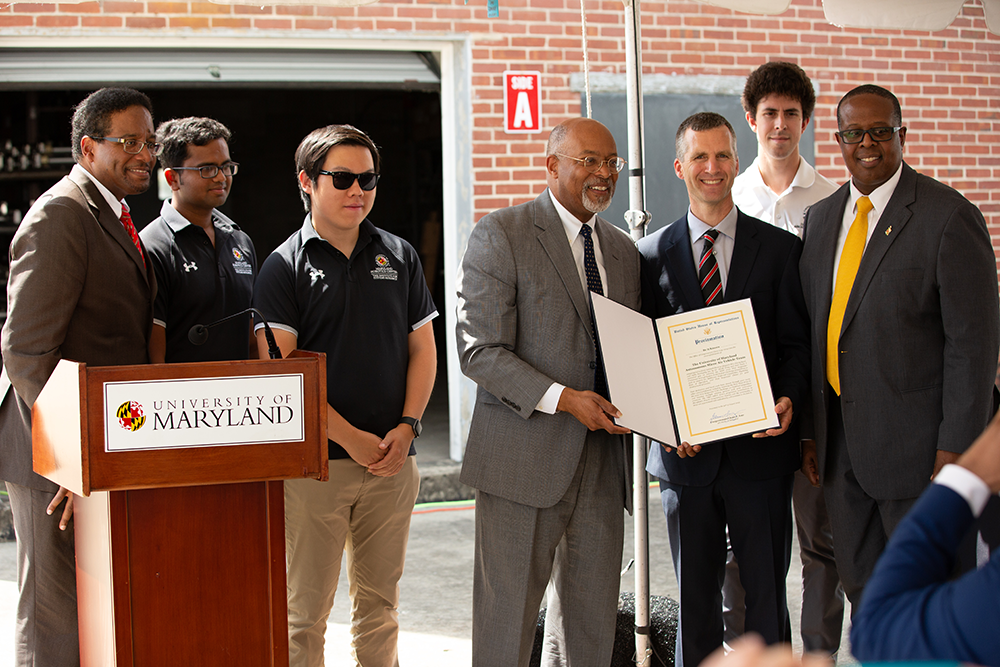
|
 |
From left: UMD President Darryll J. Pines, AMAV team lead Animesh Shastry, AMAV team design lead and pilot Qingwen Wei, U.S. Representative Glenn F. Ivey, Maryland Robotics Center Director Derek Paley, UMD UAS Research and Operations Center Project Engineer Josh Gaus, and A. James Clark School Dean Samuel Graham. Jr. |
|
University of Maryland (UMD) engineering students who built an innovative search and rescue drone were honored on Wednesday (August 30) for taking home the top prize–and a cash award of $150,000–in the National Institute of Standards and Technology (NIST) First Responders UAS Indoor Challenge earlier this year.
Representative Glenn F. Ivey (D-MD) presented members of the UMD Autonomous Micro Air Vehicle (AMAV) team with a proclamation during a special ceremony held at the Maryland Fire and Rescue Institute (MFRI) to commemorate their first place finish–the team’s second successive win in a NIST challenge of this kind.
“It’s like winning the Super Bowl two times in a row,” Ivey said of the feat, which saw the UMD students compete against competitors that included teams from private industry as well as other academic institutions.
The team’s lead, aerospace engineering doctoral student Animesh Shastry, and design lead and pilot Qingwen Wei, who graduated from UMD last spring, were on hand to demo the capabilities of the drone they call Gambit, flying it inside a facility used by the MFRI to train firefighters.
Buildings affected by earthquakes, fires, or other disasters can pose a life-threatening hazard to first responders, especially since the location of survivors needing rescue may not be known and the interiors may be unlit. The AMAV team’s drone can help. Equipped with an infrared camera that allows it to navigate in the dark, and able to fly indoors without GPS, it can locate survivors, pinpoint their locations, and enable them to communicate with rescue teams.
Gambit was designed to be easy for anyone to operate, said team advisor Derek Paley, who is director of the Maryland Robotics Center and Willis H. Young, Jr. Professor of Aerospace Engineering Education at UMD. “It uses features in the environment to stabilize the flight and send 4K video through the structure. Firefighters and first responders can remain outside the structure and get this high resolution feed of the interior,” he said.
Josh Gaus, project engineer at UMD’s UAS Research and Operations Center, joined Paley this summer as team co-advisor. The standout feature of Gambit, he said, is the integration of computer vision techniques as a pilot aid to enable maneuvering in tight spaces without advance training.
“It makes a very hard task easier,” Gaus said.
Along with Ivey, UMD President Darryll Pines delivered remarks at Wednesday’s event, hailing the victory as an example of how engineers can help address critical problems of our time, including disaster risks exacerbated by climate change.
He noted that the ceremony was being held within earshot of the historic College Park Airport, where the Wright Brothers once performed tests.
“We’re demonstrating an aviation first,” Pines said. “A drone, with technology developed by students, can fly through a building, even without light, and find individuals who might be in harm’s way. What a first-of-its-kind.”
The team also earned congratulations from Samuel Graham, Jr., dean of UMD’s A. James Clark School of Engineering. “We’re incredibly proud of these students and the things they’re able to do,” he said.
Attendees also included Prince George’s County Fire/EMS Chief Tiffany Green and Christopher Ryan from the Congressional and Legislative Affairs Office of NIST, who delivered remarks on behalf of NIST’s Public Safety Communications Research Division.
RELATED MEDIA COVERAGE
WUSA 9: “University of Maryland students using drones to help fire crews.
NBC 4 with Dominique Moody
WTOP: “U. Maryland students win national competition for drone that could help first responders save lives.”
The Diamondback: “Local leaders celebrate ‘first of its kind’ drone developed by UMD students.”
Related Articles:
Diving Deeper into Competition, and Recruitment
Yu Named Elkins Professor
Miao Yu receives NSF funding to develop ice-measuring sensors
CareDx Acquires UMD-linked Transplant Tech Firm
Baras, Sadler part of large ARL DataDrivER project
“Gambit” Pays Off in UMD Team’s Search-and-Rescue Competition Win
RoboNation ‘SeaPerch’ Robotics Competition and UMD Robotics Open House
Chahat Deep Singh's robot bee work featured in BBC video
The Falcon and the Flock
New algorithms for multi-robot systems in low communication situations
September 1, 2023
|

